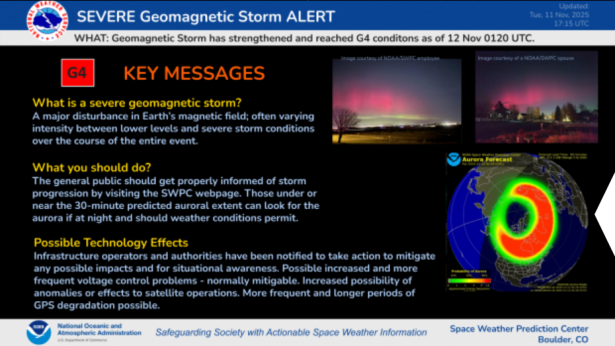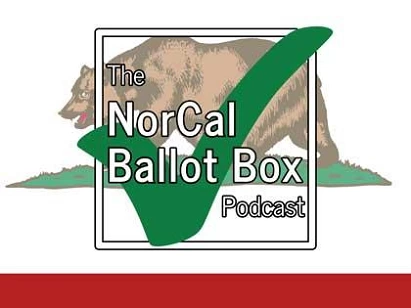 photo credit: NOAA Space Weather Prediction Center
photo credit: NOAA Space Weather Prediction CenterAn alert from NOAA's Space Weather Prediction Center for severe geomagnetic storm activity
as a result of a coronal mass ejection from the sun, on Wednesday, 12 November, 2025.
Did you notice a purple glow over the North Bay night sky Tuesday?
It was aurora borealis, the Northern Lights.
The biggest barrier for us seeing the aurora again Wednesday night likely will be clouds.
The National Weather Service has forecast overcast conditions across Sonoma County, with rain showers likely.
According to the National Oceanic and Atmospheric Administration's Space Weather Prediction Center, a third and final coronal mass ejection - that's a kind of energy release from the sun often associated with solar flares - is expected to hit Earth's atmosphere Wednesday night.
The SWPC's Michael Bettwy told KRCB News while it's hard to predict the exact effects, this geomagnetic storm could again make the aurora visible across the North American night sky.
Bettwy said people reported seeing the aurora as far south as Tampa Bay, Florida on Tuesday evening. Bettwy said, "the view-ability was influenced largely by the intensity of the storm and a favorable magnetic connection/orientation with Earth's upper atmosphere - both which allowed the aurora to expand farther south than is typically observed."
Northern California residents, including those in Santa Rosa, reported seeing vibrant colorful streaks during the first part of the geomagnetic storm's impact.
This latest coronal mass ejection is the most powerful of the year. And the Space Weather Prediction Center has classified it as severe, sending out eight-times the normal solar background radiation.
Severe geomagnetic storm activity can cause some low-frequency radio signal disruptions and degrade GPS navigation quality.
Bettwy said visible auroras are more likely in northern latitudes.
"While not unprecedented," Bettway said. "It is quite unusual for the aurora to be visible at these low latitudes; probably only occurring once or twice per solar cycle. However, during major events, like we experienced with the G5 storm in May 2024, it can expand to such low latitudes. During that event, aurora was observed in the Florida Keys and points even farther south."
Bettway said a good way to catch a glimpse of the aurora borealis is to get away from city lights, and if it's not clearly visible, to snap a picture with a smart phone, which often have cameras powerful enough to capture the night lights.

 Live Radio
Live Radio




